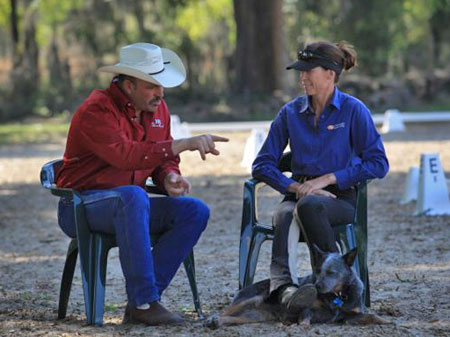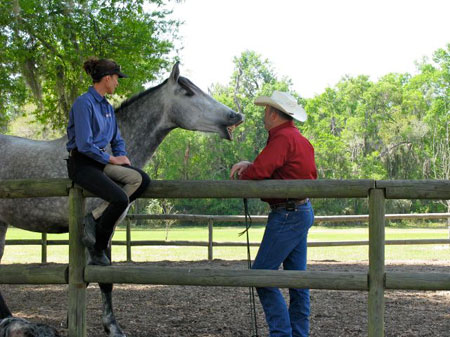"If you're not growing you're going backwards"
"Not all movement is progress"
Those are the statements that stick in my mind from Glenn Stewart's visit to The Temenos. To learn more about Glenn, visit his web site: http://www.thehorseranch.com
Maintaining Self-Awareness
These truths are not new to me. I know these things ... And if I had perfect self-awareness, I would get them right 100% of the time. Yet, I have learned that it is most difficult to keep self-awareness of this with my own personal horses. I can fall into the same common trap that I see with my students:
- Making special agreements with my horses
- Little boundaries get crossed because 'it's cute' or 'it's harmless'
- 'I don't feel like working on that today', or
- 'It doesn't really matter"
After teaching and training other people so much, sometimes I just want to go out and ride ... not always train. But oh, Karen, Karen, Karen ... Don't you remember that you are always training? Sigh.
I was so happy when Glenn Stewart called and said he wanted to visit. For one, because I consider him a friend and he is a lot of fun to be around, but also because he is an excellent horseman specializing in foundation training. Since everything always comes back to foundation, I knew there would be plenty for me to be reminded of.
Building The Foundation
The analogy that the foundation of your horse is like the foundation of a house is true, but only to a point.
Yes, the better you build your foundation the first time, the better everything is that you build on top of it.
Yes, if your foundation is crooked, or there is a piece missing, everything you build on top of it will be trying to fall apart and bracing will be 'required'.
But the analogy falls apart in that with the foundation for a house, chances are that unless you live over a sinkhole, or a fault line, once you build the foundation correctly and strongly, it will stay there. However, with horses, things are constantly evolving. Everyday is a new day. Glenn lives by the theory that if you are not growing, you are going backwards ... It was perfect timing for him to visit me.
I had been feeling a bit tired from years of extensive travel, teaching, creating the Video Classroom, designing and re-designing 3 web sites (I love all these things, don't get me wrong, but things had gotten a little out of balance). The place my head needs to go for computer work, and the place my head needs to go for clinics is not always the same head-space I need to be in to be perfect for my horses. I realized I had been letting some things slide. I am going to share some of my thoughts around this because I will bet that some of you can relate to it ...
What is 'Being Nice'?
 Since I am a person more inclined to not want to ruffle feathers, or argue, I sometimes find myself wanting to go out and just have a 'nice easy time with my horse'. But I have learned that saying these words can be predictors of a ride that ends up as exactly the opposite. I have also learned that sometimes ... In my effort to 'be nice' (what on earth does that mean to a horse?!), I end up not being as particular about things, especially on the ground. As Glenn reminded me: "Movement is not necessarily progress", and I realized that just being or moving around with my horse, without being particular, was actually making things worse. He mentioned this to the clinic group the first morning he was here. My thought was: "Uh oh... that is just what I have been doing in the moments between the 'more important' moments."
Since I am a person more inclined to not want to ruffle feathers, or argue, I sometimes find myself wanting to go out and just have a 'nice easy time with my horse'. But I have learned that saying these words can be predictors of a ride that ends up as exactly the opposite. I have also learned that sometimes ... In my effort to 'be nice' (what on earth does that mean to a horse?!), I end up not being as particular about things, especially on the ground. As Glenn reminded me: "Movement is not necessarily progress", and I realized that just being or moving around with my horse, without being particular, was actually making things worse. He mentioned this to the clinic group the first morning he was here. My thought was: "Uh oh... that is just what I have been doing in the moments between the 'more important' moments."
I am pretty darn particular about some things, but not so much with some other things with my own horses. In many moments I was merely moving around with my horses ... And my horses learned exactly what I taught them. I was creating horses who were responsive sometimes, but not at other times. This was not my intention, but it was the result of my patterns with them.
Because everything is connected, relaxing my standard on the ground, or in some given circumstances, taught my horses they could ignore me at times, and so the rides that I wanted to be 'nice and easy' sometimes ended up exactly the opposite of 'nice and easy'. They ended up being negotiations for leadership, or confusion.
Am I Alone, Here?
Any one else experienced this? This is the classic problem of the horseman who wants to be 'nice'.
I have seen this dynamic very frequently. 'Nice' people often sacrifice effectiveness and end up being not so nice because of it. The horse is left desensitized, or anxious and confused ... And the human loses confidence. Probably, the next day is worse, and the cycle continues. Or maybe the person knows they don't want to leave things not working, but they have to get frustrated and 'angry' before they finally get effective. Then they feel bad. They brew and stew all night, re-winding the tape in their head, obsessing over how they could have done it differently. Then the next day, the horse is better and part of them is happy, but secretly they still feel bad because they don't want it to work that way. They don't want the horse to be better the next day if they lost their cool the day before. In reality, what happened is the human was not so clear, didn't get the result they really wanted, but never really asked for it (expecting the horse to somehow just offer it), then finally they get clear, and even though it was out of frustration, the horse thinks: "FINALLY... Now I know what you want, why didn't you just tell me that in the first place?!'" Yes, folks, this happens to me, too.
What is really going on here? Is the answer then to get angry? For sure, no. The answer is to have the confidence, the inner strength of intention, the matter-of-fact attitude of clarity and leadership ... Everyday ... Without going through frustration and loss of patience.
It's OK to be a leader. It's OK to expect the horse to answer you. They key is to redefine what 'being nice' means.
Consistency
Nothing is nicer than the consistency of clear communication, from the beginning.
The successful, productive way to have a 'nice easy' time with your horse is to keep your standard high, but ask for easy things. Taking it easy does not mean accepting that they only do a small degree of what you are asking. Taking it easy means they give you 100% of what you are asking, but you choose to only ask for something small. When the easy things get easier, the more difficult things get easier too.
In sitting back and observing Glenn teach the clinic (what a luxury for me!), I was able to observe some very nice people, who really wanted to be nice to their horses, ending up being not as nice as they thought they were being. At times they lost their clarity and confidence, and their horses lost their responsiveness or calmness.
A Recipe for Having NOT Such a Nice Time with Your Horse:
- Don't really understand the exercise.
- Make only partial attempts to do the exercise, just to 'see what the horse does'.
- When the horse doesn't magically do what you sort of thought you wanted, apply stronger and stronger aids, hoping he will 'just do it'.
- When you find yourself at the point, where you realize 'it ain't happening', stop and give your horse a pat while telling him: "That's OK we'll try it again in a second".
- Now repeat a couple more times exactly in the same way with the same result.
- Put the horse away, this is no fun, and it was supposed to be a nice fun time with your horse.
Big Pictures, Small Details
 I always like to think: 'Where is the first place things start to go wrong?' If we can catch that moment, then it is a smaller, easier correction, than to deal with it on the other end, where everything is compounded. It's usually easier to address the small things that make a big difference, than to battle it out with the big things.
I always like to think: 'Where is the first place things start to go wrong?' If we can catch that moment, then it is a smaller, easier correction, than to deal with it on the other end, where everything is compounded. It's usually easier to address the small things that make a big difference, than to battle it out with the big things.
When I observe students who end up having one of those 'not so nice' moments, it often comes down to a problem with one of the things on the above list. Notice most of that list has to do with mental preparation. When I end up having not such a nice time, it is usually due to me not having a clear picture of what I wanted to have happen. And usually this happens when I feel mentally drained. You can not 'kind of' be a leader. If you don't want to lead that day, then really just follow your horse around. But if you are not sure what you are going to do, or what you want it to look like, it may be better to just not do it!
A Recipe for Having a Nice Time with Your Horse:
- Know what you are expecting of the horse.
- Learn/understand the exercise.
- Become clear on the visualization of the outcome you want.
- Be aware of your body-language / communication.
- Practice with focus so you and your horse gain the mental and physical coordination.
Your time with the horse is the time to share your picture with them clearly and effectively. It is not the time to be questioning whether you want to be a leader or not! By saying this I don't mean we throw away our state of curiosity, or that we stop investigating and experimenting with the cause and effect of our aids ... But if the horse asks us the question: "What do you want me to do?", I think it is important to have an answer.
I have learned that things can go downhill when I realize that if my horse asked me what I want them to do, my answer sounds something like: "I dunno, just kind of trot around a bit for a while." ;-)
Understand The Exercise
In observing students, I found the first step where things often went off during the clinic was in the understanding of the exercise. There were widely varying methods of paying attention to learning the exercise. If you don't already know the exercise it is worth it to STOP - LISTEN - and POSITION yourself where you can hear what is being said and see what is being done!
Ask questions before attempting it. Take a moment to observe it being done before attempting. This is where you also need to form a picture in your mind about what success will look like. You need to find a picture of the final version and what the steps and stages along the way will look like. If you are sure about this you will be more confident to correct when you are heading away from your goal and you will be more confident to praise and reward when you are taking even a small step towards your goal. You will have a better chance of being clear, and so a better chance of being 'nice'!
Ingredients
It always comes down to the ingredients:
- Basic boundaries
- Following a feel
- Moving from pressure
- Causing relaxation
All of these things need to be available anytime, anywhere. From there, it comes down to the self-awareness of how you are asking, and making sure your body language and timing actually says what you want it to say to the horse, or whether it conflicts. Praising and rewarding at the wrong time is just as damaging as going up your phases at the wrong time.
Every Moment Counts
Glenn's visit re-clarified a picture of clear, consistent leadership in all the moments ... Even the seemingly unimportant moments.
- The moments just walking from here to there.
- The moments where I didn't feel like training, when I just wanted to be there with my horse.
So the lesson I re-learned for the millionth time is that to be with horses in the way I want to be with horses, I always need to be like a horse in that I am always aware of the dynamic of the herd. It is the constant affirming of who gets to eat first and who gets to move whose feet that keeps the dynamic of the herd healthy and normal day to day, and moment to moment ... Including this herd of two: Me and my horse.
It just took one moment of Glenn with one of my horses to refresh my own picture of leadership for that horse and to realize where my communication had slipped. All he addressed is how she felt walking from here to there. He was clear, firm, fair and consistent. His timing was perfect. And when he got it, all I could think of was how 'nice' it was, and from the look on the horse's face I think she agreed.
I also had the opportunity to observe Glenn with some abandoned horses. He was generous enough to help out a local horse rescue who had a few horses that couldn't be caught and they needed to be relocated. To observe his leadership and communication with these horses was incredibly inspiring. They went from shaking and running in fear ... to being caught, haltered, hooves trimmed, and loaded quietly on a trailer. Every moment counted and it literally saved these horse's lives.
The challenge is to remember that every moment with your horse can be that important. It may not be a matter of life and death for you and your familiar quiet horse, but in a way, maybe it is. A life with a partner, in the presence of a great leader vs. a life with confusion and nagging seems like a pretty important choice to make, and we need to make it every day, in every moment.
Not all movement is progress ... But in all movement there is an opportunity for progress ... And if you're not progressing, you're going backwards. The nicest thing you can do for your horse is to be clear and consistent.



